10 Endangered Ocean Species and Marine Animals
Our ecosystem comprises interdependent animals and plants, constituting a complex web of life. This variety of life on earth, the biodiversity that features numerous interactions among the species, is vital to the existence of our planet. Thus, the extinction of a single species may affect the whole biological system.
Unfortunately, the intervention of human beings in nature is pushing several species to the brink of extinction due to deforestation and habitat destruction. Hence, real and practical conservation efforts are needed.
From unknown creatures to Charismatic megafauna, these disappearances in the ecosystem happen frequently. On land, wildlife like orangutans, Black Rhinos, Amur Leopard, and Giant Pandas are some of the most critically endangered species in the world.
Similarly, many marine species, including North Atlantic Right Whale, Whale Sharks, Asian Giant Softshell Turtle found in Southeast Asia, porpoises, bluefin tuna, sea otters, manatee, and fur seals are on the edge of extinction as climate change, habitat loss and overfishing become a major threat to their existence.
According to the International Union for Conservation of Nature (IUCN), hundreds of marine species across the world come under endangered and critically endangered categories.
The IUCN red list determines the status of species by considering the probability of their extinction, breeding levels, current population, and other factors. Some of the endangered and recognizable marine species are named here.
Let’s take a look at ten endangered marine animals.
1. Hawksbill Turtle (Eretmochelys imbricate)
Found in the tropical regions of all the world’s oceans, gulfs and seas- mostly in coral reefs, the Hawksbill Turtle’s population has been estimated to have declined by 80% over the last century.
Known to be a subject of heavy trafficking in the tourist trade in tropical regions for their meat and shells, these turtles have been killed mercilessly for quite a period.
The colourful shells of the Hawksbill Turtle, with beautiful patterns, make them a valuable item in the market, often sold as “tortoiseshell.”
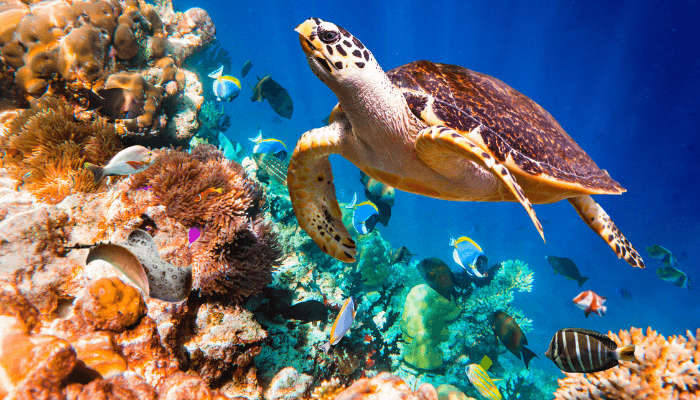
Even though harvesting its eggs is banned in many countries, the practice could not be ceased entirely. The declination of its population has also resulted due to the degradation of coral reef species, which the Hawksbill Turtle primarily feeds on.
According to marine conservatives, this family of the turtle is the living representatives of reptiles that have existed in our oceans for the past hundred million years, and these turtles are vital for the existence of seagrass beds and coral reefs.
2. Vaquita (Phoeocna sinus)
An inhabitant of the shallow, murky waters off the shore of the Baja Peninsula in Mexico, Vaquitas are the world’s smallest and critically endangered cetaceans.
This rare marine mammal is on the brink of extinction only a half-century after its first sighting. Features of Vaquita include the dark rings around their eyes, lips with dark patches, and a thin line from the mouth to dorsal fins.
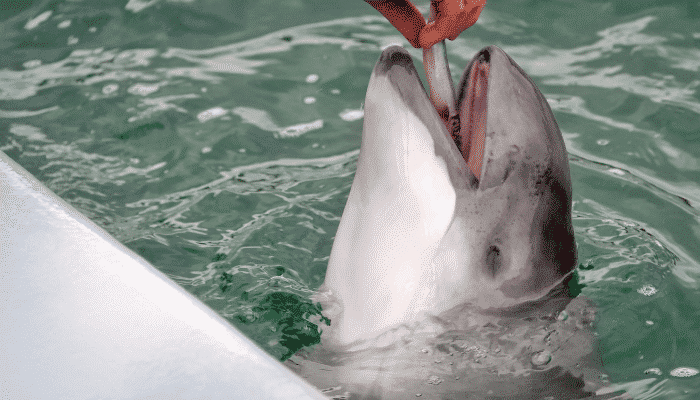
Extensive use of gill-netting for fishing in the Gulf of California has endangered this marine species, resulting in a gradual drop in population since the 1940s.
The gill-netting operation may have ceased to exist in 1970, but the population fall persists for as much as 15% yearly.
According to reports, there are only a dozen of these marine mammals left in the world since the percentage of decline in their population was as much as 90% since 2011.
3. Blue Whale (Balaenoptera musculus)
The largest living mammal on earth, the blue whale, belongs to the baleen whales and features more than 100 feet in length and around 200 tonnes in weight.
There are at least three subspecies of Blue whales, and these could be found migrating from both poles in the oceans around the world. Sitting on top of the food chain, whales have a significant role in maintaining a healthy marine environment.
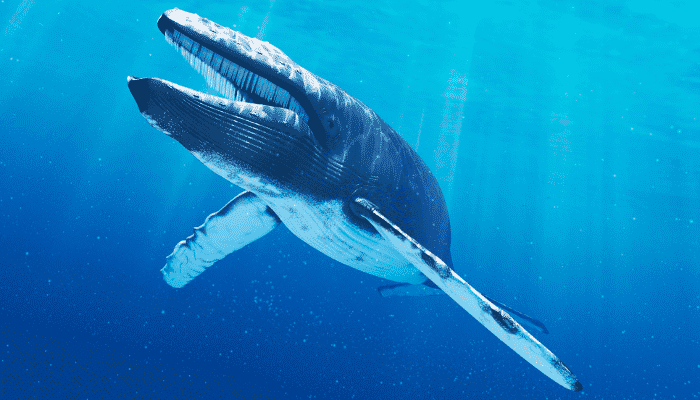
Unfortunately, excessive commercial hunting has drastically decreased its population and now has threatened its mere existence even though an international ban was constituted in 1966. According to IUCN’s 2016 estimate, the global population of the Blue Whale is 10,000–25,000.
Watch the blue whale video here.
4. Kemp’s Ridley Sea Turtle (Lepidochelys kempii)
The Kemp’s Ridley sea turtle, also known as the Atlantic Ridley sea turtle, is endangered by the rarest and smallest sea turtle. Sea turtles are threatened by oil spills, lack of food, marine pollution, and entanglement in fishing gear.
Primarily found in the Gulf of Mexico, the Kemp’s Ridley sea turtle often migrates to the Atlantic Ocean only to come back to lay eggs. This group of turtles has a unique way of nesting. The female turtles arrive in large numbers- a procession called Arribadas- on a single beach to lay eggs.
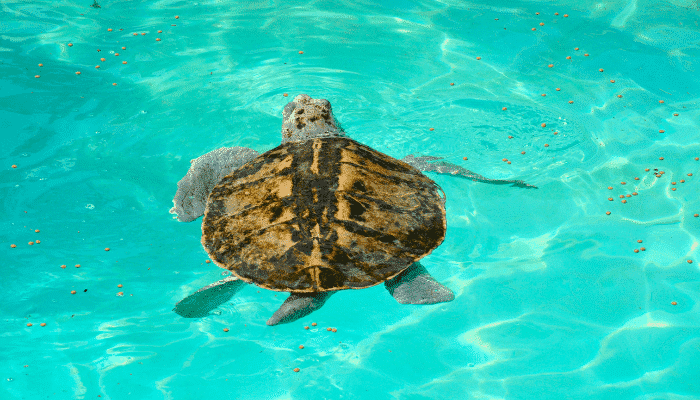
Unfortunately, the conditions such as loss of habitat, marine pollution, entanglement in fishing nets, etc., have resulted in the huge decline of the population of the Kemp’s Ridley sea turtle.
Thus, harvesting of eggs has been made illegal, and research projects of incubating and hatching the eggs in temperature-controlled rooms have been undertaken to save this endangered marine species.
Watch the video of Kemp Ridley Sea Turtle here.
5. Steller Sea Lion (Eumetopiasjubatus)
The largest member of the Otariid family and the fourth largest of all seal species, this eared seal could be located in the cold coastal waters of the North Pacific. Also known as the northern sea lion, the species is named after Georg Wilhelm Steller, a naturalist who first discovered them in 1741.
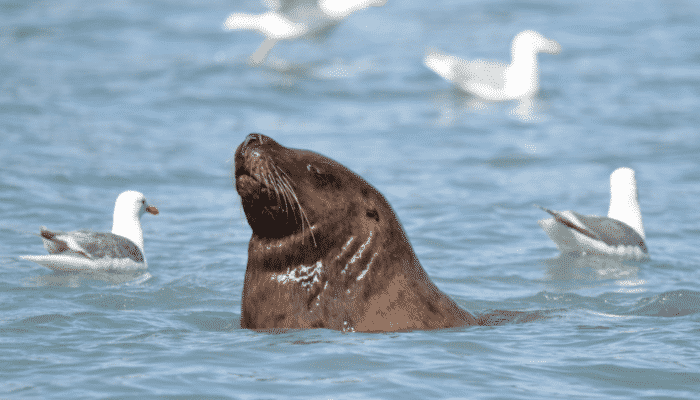
The high risk of predation by Killer Whales and fishing and harvest by native Alaskans and Canadians for meat, oil, hides, and other by-products make this marine life vulnerable to endangerment.
According to reports, its population has declined by more than 60% due to natural and human threats since the 1960s. However, the eastern Steller sea lion was omitted from the U.S. Endangered Species List in 2013 after increasing population in recent years.
Watch the video of Steller Sea Lions here.
6. Hammerhead Shark (Sphyrna mokarran)
Traced in the tropical regions of the oceans around the world, the Hammerhead shark belongs to the family Sphyrnidae and is given the name because of its “hammer” shaped head.
The Hammerhead sharks typically have 0.9 to 6.0 m in length and up to 580 kg in weight. Known as aggressive hunters, these sharks feed on smaller fish, squid crustaceans, and octopuses, while there are reports of unprovoked attacks on humans by the shark.
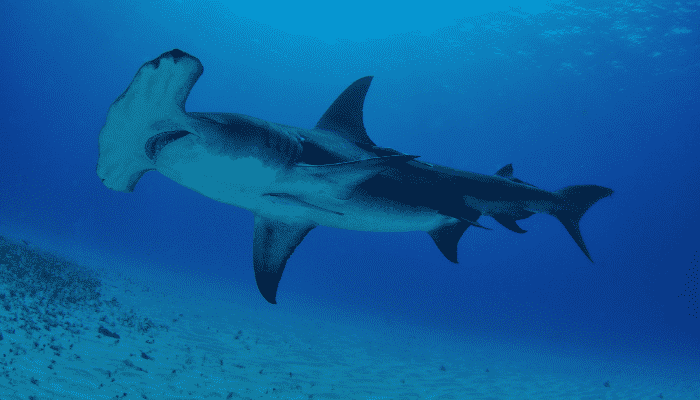
These migratory sharks are subjected to being victimized for their fin. Even the process is horrifying as the sharks are caught by fishers, dragged on board, and cut off their fins while still breathing.
The remaining carcass is thrown into the water, and eventually, it bleeds to death. Albeit there is a ban on shark finning in many countries, the result has been abortive as the demand and high price paid for it in the Asian market drive the illegal harvest system, endangering these marine species’ survival.
7. Fin Whale (Balaenopteraphysalus)
Also known as the common rorqual, the Fin whale is the second-largest mammal on the planet after Blue Whale. With a maximum length of 25.9 meters, the Fin Whale has an estimated weight of about 114 tonnes. Like all the other whales in our oceans, the Fin Whale is also a victim of hunting. According to estimates, the global population of Fin Whale ranges from below 100,000 to around 119,000.
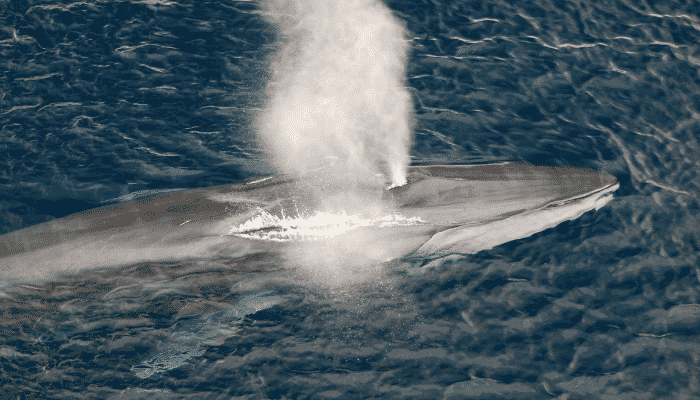
Humpback Whale, another rorqual species, has also been listed as an endangered marine species. Before the introduction of the whaling moratorium in 1966, these species were hunted for their fur and flesh for meat, while the population dropped by 90%. Currently, around 2,500 Humpback Whales survive in the world.
8. Hector’s Dolphin (Cephalorhynchushectori)
Found off the coast of New Zealand, Hector’s Dolphins are the smallest dolphin in the world and the most prominent dolphin in the genus Cephalorhynchus. Mostly sighted around the South Island, the world’s rarest dolphins’ features include black markings on the face, stocky bodies, and creamy white throat and belly. One group of Hector’s Dolphin is made of two to eight members.
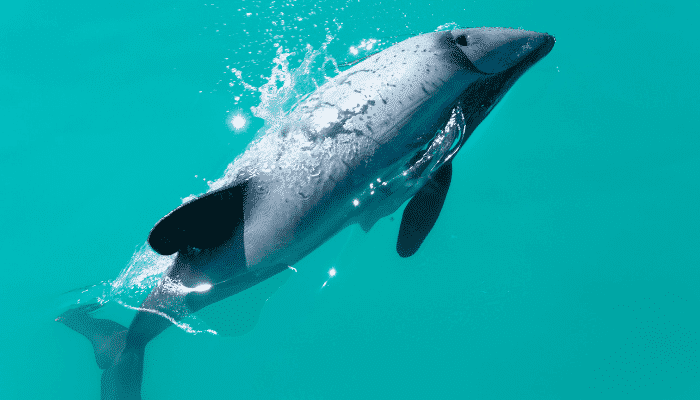
Unfortunately, there is a significant decline in their population as trawl fisheries, and bottom-set gill nets cause the death of these species. Most deaths happen in the fishing nets. One of the two sub-species of Hector’s Dolphin, Maui’s dolphin, is considered the most endangered. According to the survey conducted by the New Zealand Department of Conservation in 2010-11, the estimated population of these dolphins is 55.
9. Hawaiian Monk Seal (Monachusschauinslandi)
A native of the Northwestern Hawaiian Islands, Hawaiian Monk Seal is one of the earless seals who live on warm beaches, unlike other seals.
This endangered marine mammal is one of the two remaining in this species-monk seal- along with the Mediterranean monk seal. The third species from this family, the Caribbean monk seal, has already disappeared from the planet.
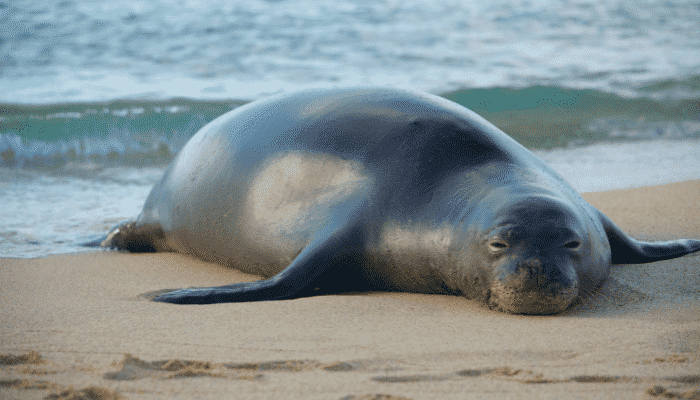
According to recent research, only 1,400 Hawaiian Monk Seal remain on the Islands. These seals are threatened by commercial hunting for meat, oil, and skin, attack from predators including tiger sharks, marine debris, and entanglement in fishing nets.
10. Green sea turtle (Cheloniamydas)
One of the largest sea turtles, the Green Sea Turtle, is a herbivore in the tropical and subtropical seas. The species is named after the colour of the fat found underneath its carapace. Like many other turtles, Green Sea Turtles migrate from hatching beaches to feeding grounds.
Since these sea turtles are a popular food, the hunt for turtles and their eggs threatens their lives. The loss of sandy beaches and careless fishing have reduced their population.
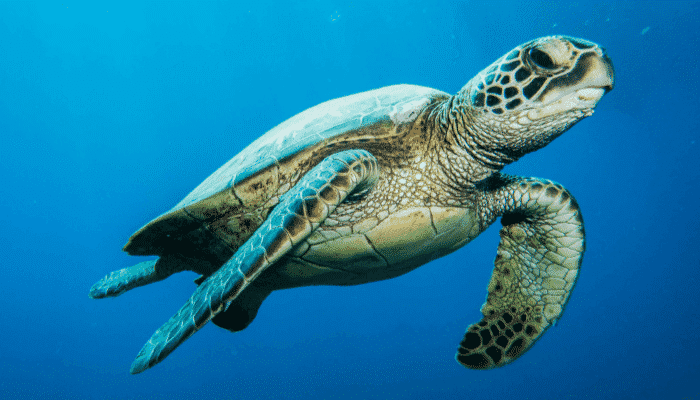
Apart from these mammals and turtles, salmonids and seabirds also have confronted the menace of endangered ocean species. The Maritime Mammal Protection Act (MMPA-1972) and The Endangered Species Act (ESA-1973) have significantly salvaged this ocean life. Still, it requires adequate awareness of these issues and the transcendence of human behaviour following that, which can inevitably make a difference for these ocean-endangered species.
Frequently Asked Questions About Endangered Animals
1. What are some endangered animals found in the ocean?
Sea turtles, manatees, whale sharks, bottleneck dolphins, sawfish, dugongs, great white sharks, humpback whales, etc., are a few endangered marine animals.
2. How many sea animals are endangered?
Approximately 2270 marine species are listed as endangered in the U.S. Endangered Species Act.
3. How many sea animals are there on earth?
There are about 2.2 million identified species on earth. Scientists believe that a majority are waiting to be discovered.
4. What causes the extinction of marine species?
Global warming, marine pollution, habitat loss, and oxygen depletion are the main reasons for the mass extinction of marine species.
5. What is the rarest ocean animal?
Vaquita is the world’s rarest marine animal.
You might also like to read:
- Effects of Dredging on the Marine Environment
- How Efficient Cargo Handling can be Helpful for the Marine Environment?
- 11 Threats to Marine Environment You Must Know
- 13 Important Marine Environmental Protection Agencies
- How is Plastic Ruining The Oceans In The Worst Way Possible?
- What is Plastic Aquatic Project?
Disclaimer: The views mentioned above are of the author only. Data and charts, if used in the article, have been sourced from available information and have not been authenticated by any statutory authority. The author and Marine Insight do not claim it to be accurate nor accept any responsibility for the same. The views constitute only the opinions and do not constitute any guidelines or recommendations on any course of action to be followed by the reader.
The article or images cannot be reproduced, copied, shared, or used in any form without the permission of the author and Marine Insight.
Do you have info to share with us ? Suggest a correction
Subscribe To Our Newsletters
By subscribing, you agree to our Privacy Policy and may receive occasional deal communications; you can unsubscribe anytime.



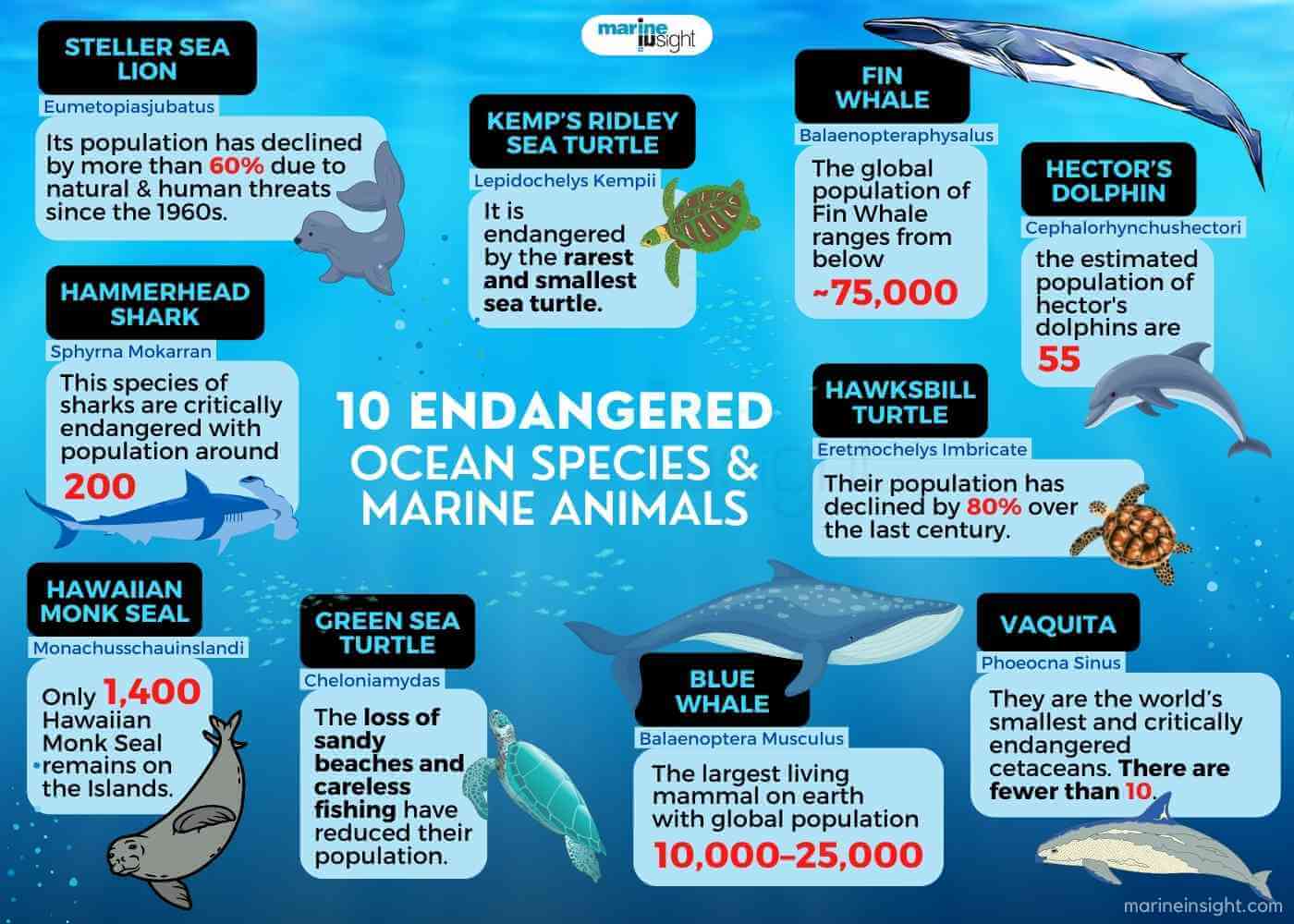

Humpback whale numbers are not as low as reported; between Hawaii and Alaska alone they number near 11,000, and they are also of least concern on the IUCN Red List. Not mentioned are the critically endangered Maui’s dolphin of New Zealand.
we need to help the humpback whales by stop fishing or take care of what you do with fishing gear leave humpback whales alone !
we need to look after humpback whales !!!!!!
my name is britttany and i am a blob fish
Friend me on Facebook. LOL
I just read this because i was doing a project for school and i saw this i found this very surprising.
Overall i really liked this
we will help with those andanger mammals cuz they will need it even if i have to do chertie work for them cuz they need
Hi
blobfish
rewa hard
hi
I’m doing a speech about this in school and I have to restart it!
XD
wow thanks that’s really going to help me for my homework !!!!!!!!
x)
this is really awsome
We should really save these animals as they are very specific .
help all the endangered animal s!!!!!’mn
i will become part of sea world’s rescue team and save endangered speicies
Save the sea life!!!
doing an project totally into saving sea life!!
hopefully they have more to look forward to
more than extinction.
#lovethesea
SAVE THE SEA!!!!!!!
OR JUST THE TURTLES GODDA LOVE DEM TURTLES!!!
I’m sad about these animals and I want to raise money for these animals.
is blue whale endangered or extinct
Help save our planet!!!! Do not over fish, don’t pollute our water streams, and keep our marine life alive!!!!
hi i love seals
turtles are nice what did they do to us?
I’m with #amazing
this is sooooooooooooooooooooooo helpful
I had to do an essay on MARINE endangered animals not just endangered animals. So I have to start my whole essay again. >:(
you forgot maui dolphins!!!!!!!!!!!!!!!!!!!!!!!!!!!!!!!!!!!!!!!!!!!!!!!!!!!!!!!!!
i think that it is really helpful for my work that i need done
Well this is helpful
Hello I had to do this for homework and it helped I guess.
Hmm I’m the real Moana
hello:)
i was just surfing the web for a school project and when i saw this i was so shocked! what they are doing ti the hammerhead sharks is not fair!!!!
turtles are the best
Very Informative, Please keep writing and spread such beautiful information.
I like turtles
i like turtles too <3
This sounds like the work of an american made nuclear power plant that blew up in Japan not that it’s due to over fishing. We have been over fishing for generations….. Wake up wwf…
This is a fantastic website to use and I am working on vaquita
Wow i find this so cool guys we have to save our oceans because if we don’t do something now then our plastic in seas and polluted rivers is gonna have an effect on the earth!
OMG! I love this slide! It was super helpful. Also, sub to Mr. derp melon and Pewdiepie!!!!!!
LETS SAVE THESE ANIMALS!!!! don’t post things like Hi talk about what we really need to do HELP THESE POOR THINGS!!!!
if only people understood what a difference a small gesture makes. we can help save these animals if we stop littering and start picking up the litter!
(AMAZING SLIDE!) very recommended
save the turtles
@KElsey: ??
soo… sad for those animals 🙁 🙁
?
Do you know about the sea clff
WE NEED TO SAVE THE LIONS!!!!!!!!!
LETS GO!!!!!!!!!!!!!!!!!!
this is sooo amazing i love this website
this is help full
We are glad.
Fisherman are monsters!! We have to save these poor animals! There are more endangered animals and this is just some of them and there is so many animals in this world, that we don’t need anymore lost like the dinosaurs. We still have dinosaurs today; the turtle. I have studied this article, it has helped a lot, thank you so much
I love this article and the world should start focusing on this more!
Thx everybody so much this really helped and this articular is the best
My grandma is cutting fishes now and I wish for her to stop
Creatures have hearts that vibe, eyes that see, and families to really focus on, very much like you and me. One day we will realize that all creatures have soul. Was looking for some takes regarding this topic and I found your article quite informative. It has given me a fresh perspective on the topic tackled. Thanks!